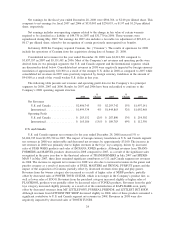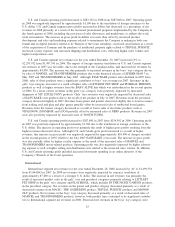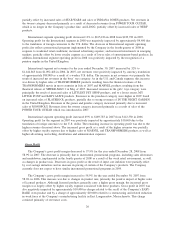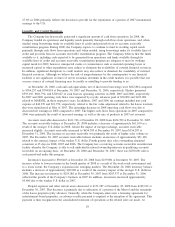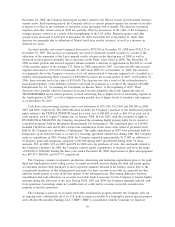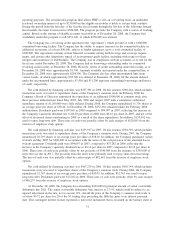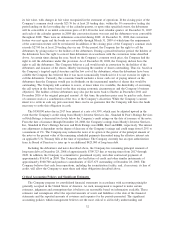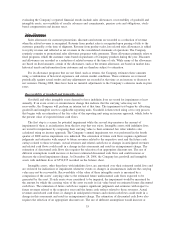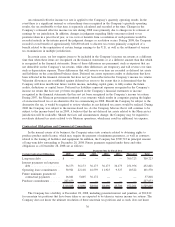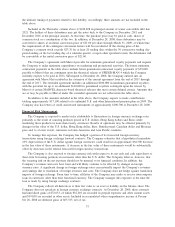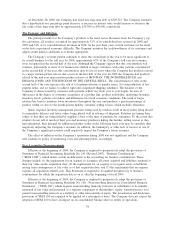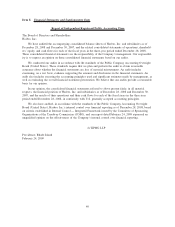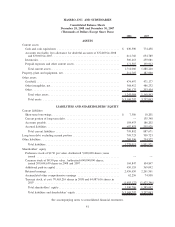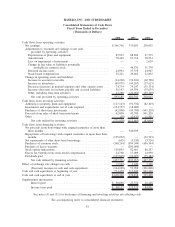Hasbro 2008 Annual Report Download - page 43
Download and view the complete annual report
Please find page 43 of the 2008 Hasbro annual report below. You can navigate through the pages in the report by either clicking on the pages listed below, or by using the keyword search tool below to find specific information within the annual report.
evaluating the Company’s reported financial results include sales allowances, recoverability of goodwill and
intangible assets, recoverability of royalty advances and commitments, pension costs and obligations, stock-
based compensation and income taxes.
Sales Allowances
Sales allowances for customer promotions, discounts and returns are recorded as a reduction of revenue
when the related revenue is recognized. Revenue from product sales is recognized upon passing of title to the
customer, generally at the time of shipment. Revenue from product sales, less related sales allowances, is added
to royalty revenue and reflected as net revenues in the consolidated statements of operations. The Company
routinely commits to promotional sales allowance programs with customers. These allowances primarily relate to
fixed programs, which the customer earns based on purchases of Company products during the year. Discounts
and allowances are recorded as a reduction of related revenue at the time of sale. While many of the allowances
are based on fixed amounts, certain of the allowances, such as the returns allowance, are based on market data,
historical trends and information from customers and are therefore subject to estimation.
For its allowance programs that are not fixed, such as returns, the Company estimates these amounts
using a combination of historical experience and current market conditions. These estimates are reviewed
periodically against actual results and any adjustments are recorded at that time as an increase or decrease to
net revenues. During 2008, there have been no material adjustments to the Company’s estimates made in prior
years.
Recoverability of Goodwill and Intangible Assets
Goodwill and other intangible assets deemed to have indefinite lives are tested for impairment at least
annually. If an event occurs or circumstances change that indicate that the carrying value may not be
recoverable, the Company will perform an interim test at that time. The impairment test begins by allocating
goodwill and intangible assets to applicable reporting units. Goodwill is then tested using a two step process
that begins with an estimation of the fair value of the reporting unit using an income approach, which looks to
the present value of expected future cash flows.
The first step is a screen for potential impairment while the second step measures the amount of
impairment if there is an indication from the first step that one exists. Intangible assets with indefinite lives
are tested for impairment by comparing their carrying value to their estimated fair value which is also
calculated using an income approach. The Company’s annual impairment test was performed in the fourth
quarter of 2008 and no impairment was indicated. The estimation of future cash flows requires significant
judgments and estimates with respect to future revenues related to the respective asset and the future cash
outlays related to those revenues. Actual revenues and related cash flows or changes in anticipated revenues
and related cash flows could result in a change in this assessment and result in an impairment charge. The
estimation of discounted cash flows also requires the selection of an appropriate discount rate. The use of
different assumptions would increase or decrease estimated discounted cash flows and could increase or
decrease the related impairment charge. At December 28, 2008, the Company has goodwill and intangible
assets with indefinite lives of $550,235 recorded on the balance sheet.
Intangible assets, other than those with indefinite lives, are amortized over their estimated useful lives and
are reviewed for indications of impairment whenever events or changes in circumstances indicate the carrying
value may not be recoverable. Recoverability of the value of these intangible assets is measured by a
comparison of the assets’ carrying value to the estimated future undiscounted cash flows expected to be
generated by the asset. If such assets were considered to be impaired, the impairment would be measured by
the amount by which the carrying value of the asset exceeds its fair value based on estimated future discounted
cash flows. The estimation of future cash flows requires significant judgments and estimates with respect to
future revenues related to the respective asset and the future cash outlays related to those revenues. Actual
revenues and related cash flows or changes in anticipated revenues and related cash flows could result in a
change in this assessment and result in an impairment charge. The estimation of discounted cash flows also
requires the selection of an appropriate discount rate. The use of different assumptions would increase or
33



